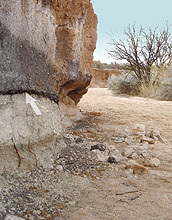A GIANT meteor or comet fragment - the size of some of those which last week collided with Jupiter - may have played a key role in determining human history, according to new evidence.
Scientific investigations suggest that a collision between Earth and a celestial body may have been partially responsible for the final demise of classical civilisation and the onset of the Dark Ages.
David Morrison
NASAFri, 24 Aug 2007 08:20 UTC
Napier et al. assert that life originated in comets, not on planets like Earth. Kennett et al. believe that a large comet impacted North America just 13,000 years ago, causing a mass extinction. For a critique, read on.
Comment: Seems the people at NASA still don't like cometary showers invading the inner solar system. Their "evidence" is the lack of evidence that would explain what their theories predict about comets, dismissing the compelling evidence "on the ground", albeit a lack of a crater, but that could be explained if the comet impacted the Laurentide ice sheet itself, despite their dismissals. It's as if the Inquisition demanded Galileo disprove the bible's contention that there are four corners of Earth before proposing the theory that the earth is, in fact, round. And what about
this crater discussed
here? And what about the
Carolina Bays?
It is generally accepted today that the Tunguska event can only be attributed to a rare encounter with a "comet," or incoming body of such a nature that it left no stony or ferrous material, but simply vaporized and scorched the earth below in a rare display of high energy physics.
To explain the Bays, Kobres proposes a similar encounter, albeit of larger proportions and more accurately described as a "near miss." The "Kobres Event" proposes that a "comet," if you like, whipped past the Earth, exchanging enormous energy but not impacting directly to form a typical crater. It is demonstrable that such an encounter would show an intense flash of heat onto the ground below. This heat would have caused moister portions in the Pleistocene landscape to explode into steam, leaving the depressions in the ground that we know today as "Carolina Bays."
A rare meteor shower predicted to hit Earth on 1 September should give astronomers only their second chance to study an ancient comet's crust. It could also help them develop a warning system against an otherwise insidious threat - a comet aimed at Earth from the dark fringes of the solar system.
For the first time, there is solid data to refute a popular theory that life came to Earth aboard a comet, Rutgers researchers say.
Deteriorated DNA from microbes, frozen for millions of years in the Antarctic ice, shows that organisms could not have survived the bombardment of cosmic radiation during deep space travel from outside the solar system, said Paul Falkowski, a Rutgers biologist and oceanographer.
SPXTue, 31 Jul 2007 15:47 UTC
Since 1986, four different comets -- Halley, Borrelly, Wild 2 and Tempel 1 -- have been examined in impressive detail by a wide variety of American, European and Russian spacecraft, including one that has actually returned a small dust sample to Earth and another that crashed a large piggyback spacecraft into a comet's nucleus to try and reveal some of its subsurface structure. And in 2014, the still more ambitious European "Rosetta" mission will rendezvous with the nucleus of a fifth comet (Churyumov-Gerasimenko), examine it from just 25 kilometers away (or less) for over a year and a half, and even drop a small survivable lander onto the nucleus' surface.
All this attention is entirely justified, given the fact that comets are the only preserved pieces of the "planetesimals" that were made by accretion out of the initial dust, ices and gas of the primordial pre-Solar System nebula itself, and which in turn merged together to form the planets.
It was so faint amid the star-freckled blackness that professional star-gazer Lin Chi-sheng missed it as he photographed the heavens from Lulin Observatory, Nantou County, earlier this month.
Luckily, Lin's camera, recording time-lapse images of space through the observatory's telescope, didn't miss it -- a mighty chunk of ice and rock "a few kilometers" in diameter and hurtling toward Earth: "Asteroid C/2007-N3."
Tony Long
WiredSat, 21 Jul 2007 05:46 UTC
1862: American astronomer Lewis Swift discovers the presence of a large comet that will soon bear his name. Three days later, another American astronomer, Horace Tuttle, makes the same sighting. So this heavenly body comes down to us as the Comet Swift-Tuttle.
Based on their observations, and those of other astronomers who began tracking the comet's highly elongated orbit, it was calculated that Swift-Tuttle would make its next appearance during the 1980s. They were close. Japanese astronomer Tsuruhiko Kiuchi rediscovered the comet in 1992.
Comet LINEAR (C/2006 VZ13), now crossing through Draco and Boötes, has far exceeded expectations. It was originally predicted to peak in brightness around magnitude 10, a pleasant spectacle for people who enjoy viewing faint comets through telescopes. But the latest magnitude estimates range from 7.5 to 8.0, making it an easy sight through 10×50 binoculars in a dark, transparent sky.
IOLThu, 12 Jul 2007 03:29 UTC
A dying comet has prompted astronomers to take issue with a mainstream theory about the impact of "space weather" on these enigmatic wanderers of the Solar System.

Comment: Seems the people at NASA still don't like cometary showers invading the inner solar system. Their "evidence" is the lack of evidence that would explain what their theories predict about comets, dismissing the compelling evidence "on the ground", albeit a lack of a crater, but that could be explained if the comet impacted the Laurentide ice sheet itself, despite their dismissals. It's as if the Inquisition demanded Galileo disprove the bible's contention that there are four corners of Earth before proposing the theory that the earth is, in fact, round. And what about this crater discussed here? And what about the Carolina Bays?